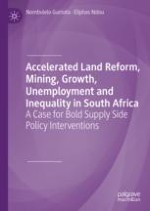2019 | OriginalPaper | Buchkapitel
13. The Impact of Mining Commodity Price Booms and Sharp Exchange Rate Depreciation Episodes on Mining Output and Employment Growth
verfasst von : Nombulelo Gumata, Eliphas Ndou
Erschienen in: Accelerated Land Reform, Mining, Growth, Unemployment and Inequality in South Africa
Aktivieren Sie unsere intelligente Suche, um passende Fachinhalte oder Patente zu finden.
Wählen Sie Textabschnitte aus um mit Künstlicher Intelligenz passenden Patente zu finden. powered by
Markieren Sie Textabschnitte, um KI-gestützt weitere passende Inhalte zu finden. powered by
